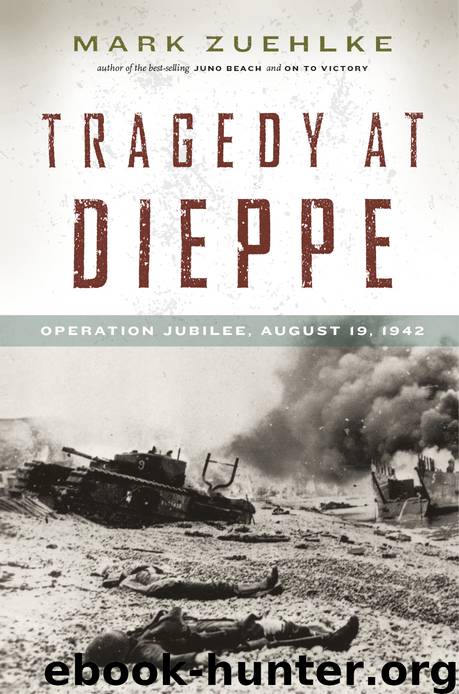Tragedy at Dieppe by Mark Zuehlke

Author:Mark Zuehlke
Language: eng
Format: epub
Tags: HIS027160
Publisher: Douglas & McIntyre
Published: 2012-09-03T16:00:00+00:00
16. Hell of a Fix
The queen’s own Cameron Highlanders had crossed the channel in R-Boats without incident. They were to land at 0520 hours. Lieutenant Colonel Al Gostling’s gut told him the South Saskatchewan Regiment would be unable to seize both headlands in just thirty minutes. So he asked naval officer Commander H.V.P. McClintock to delay the landing ten minutes. After agreeing, McClintock made several critical errors. “Had we trusted to our dead reckoning and continued at a steady course and speed from our turn on to the last leg of the track laid down we would have made the correct beach about 10 minutes late, which was the time we were aiming for,” he later admitted. “Unfortunately when we sighted the coast we thought we seemed rather close and made a reduction in speed... Later when we could see a bit more we thought that we were rather too far to the eastward and made an unnecessary alteration of course which we later had to correct.”1
It was broad daylight as the R-Boats closed on the beach. Aboard one carrying a ‘B’ Company platoon that included Private G.L. Bird, “everybody was in the best of spirits, singing and joking.” A thousand yards offshore, the Germans began firing from the eastern headland with machine guns, mortars, and light artillery.2 Shells threw up spouts of water.3 Gostling “was very cool and collected,” explaining the different types of fire. “Listen to that, that’s mobile artillery,” he shouted.4 Amid the explosions and firing guns, the Camerons heard also the skirl of pipes. ‘B’ Company’s piper, Corporal Alec Graham, stood defiantly at one boat’s bow. Company Sergeant Major George Gouk recognized “A Hundred Pipers,” ‘B’ Company’s march-past music. Then the boats grounded “on a gravel beach with shells bursting pretty close.” Captain Norman Young leading, the men jumped off the bow.5
Touchdown was 0550 hours, twenty minutes later than Gostling had desired. The entire battalion was to have been put down east of the river but instead ended up scattered all along Green Beach. This left the Camerons divided by the river. The largest group, consisting of Major Norman Ross’s ‘A’ Company, two ‘B’ Company platoons, most of the men in three ‘C’ Company platoons, and battalion second-in-command Major Andy Law’s headquarters section, landed west of the river.6
Gostling’s landing craft correctly landed east of the river but right next to the headland. As Gostling led the men off the boat, a burst of fire from a pillbox killed him instantly. Captain John Runcie, leading ‘D’ Company, saw Gostling fall—likely the first Cameron to die.7 More men died in the dash for the seawall. They had been led to believe the beach was mostly sand and light gravel. Instead, Law encountered shingle “about the size of eggs and terrible to cross.” The seawall, also reportedly only two to three feet high, presented an eight-foot-tall obstacle.8
The Camerons with Runcie “crowded in front of it, taking shelter from machine-gun and mortar fire coming from the left... The plan had been for ‘A,’ ‘B,’ and ‘C’ Companies.
Download
This site does not store any files on its server. We only index and link to content provided by other sites. Please contact the content providers to delete copyright contents if any and email us, we'll remove relevant links or contents immediately.
| 19th Century | 20th Century |
| Exploration | First Nations |
| Founding | Pre-Confederation |
| Province & Local | War of 1812 |
Cat's cradle by Kurt Vonnegut(13902)
Pimp by Iceberg Slim(12950)
Underground: A Human History of the Worlds Beneath Our Feet by Will Hunt(11268)
4 3 2 1: A Novel by Paul Auster(11078)
The Radium Girls by Kate Moore(10922)
American History Stories, Volume III (Yesterday's Classics) by Pratt Mara L(4829)
Perfect Rhythm by Jae(4630)
Wiseguy by Nicholas Pileggi(4603)
The Fire Next Time by James Baldwin(4352)
Paper Towns by Green John(4179)
A Higher Loyalty: Truth, Lies, and Leadership by James Comey(4043)
Pale Blue Dot by Carl Sagan(4018)
The Mayflower and the Pilgrims' New World by Nathaniel Philbrick(3921)
The Doomsday Machine by Daniel Ellsberg(3741)
Too Much and Not the Mood by Durga Chew-Bose(3702)
Killers of the Flower Moon: The Osage Murders and the Birth of the FBI by David Grann(3627)
The Borden Murders by Sarah Miller(3597)
The Sympathizer by Viet Thanh Nguyen(3527)
Killing England by Bill O'Reilly(3465)
